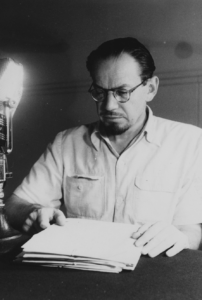My Hero in My Homeland

Very few books can be emotionally as promising as “The Road to Mecca”. Written by a famous and yet obscure author, Muhammad Asad (earlier Leopold Weiss). The book is a memoir, chiefly of his days in Arabiya.
Born in Austria to Jewish parents, Asad was introduced in the study of the Torah apart from secular education. But following his internal urges and constant restlessness, he rather took up journalism very early in his life abandoning his University along with the financial and moral support of his family. This adamant restlessness played a crucial role throughout his life and even made his Jewish self dive deeper into the consciousness of the Palestinian Muslims when he moved to Palestine during the days of the formation of Israel. It was there that he began his journey- both physical and spiritual- covering places right from the mountains of Morocco to the islands of Malaysia.
The journey is so enchanting that while reading about it, one seems to be accompanying him in the streets of Jerusalem, hearing the resounding muezzin’s chants in Cairo, among the worshippers in the Umayyad Mosque of Damascus, praying in the wilderness of Najd, sleeping in the Bedouin tents of Jordan, in the darkness of Libya, among the oppressed revolutionary masses of Tehran, watching whirling dervishes in Scutari, on the steep slopes of Hind Kush and in many other exciting places. But these “other” exciting places don’t find a mention in the memoir and subsequently make the reader experience some of his restlessness, the restlessness to know how he would have seen and decorated in words the rest of the world he visited, and, more importantly, to know about his friendship with Allama Iqbal and his representation of Pakistan in
the UN, the mention of which were-present in the prologue.
The very same restlessness had certainly taken roots in my consciousness. And today, when I look back at those moments I spent with “The Road to Mecca” in Srinagar, I realize that the book has had a deep impact on my nascent intellect. Perhaps it was one of the catechisms of my childhood, and thus, it now has a great influence on my perception of life both tangible and intangible. The book certainly has a distinction of its own, which is, as I understand today, its humaneness: trying to appeal to my spiritual hunger, my romantic longings and my intellectual needs all at the same time. The urges so intimately are woven together in man and so beautifully reflected in the book. After all, it was but the story of a man discovering Islam while lost in the lights of Europe and the sands of Arabiya.
Over time, I collected most of Asad’s available books but, although being equally amazing, they were objective in their approach, contrary to being the siblings of “The Road to Mecca”. Among them, “Islam at the Crossroads” is quite popular. But then I was able to procure one of its siblings, albeit the eldest one- “Unromantic Orient”, which was the first written by him and finds a mention in the memoir. Later I archived a bit of his memory on it by getting it autographed by his famous admirer, Tariq Ramadan- son of Asad’s close friend, Said Ramadan.
Then one day, I was stopped dead in tracks, a sort of reaction I otherwise reserve only for the tear gas shells often fired outside my ancestral home in the Old City. I was reading Martin Cramer’s article about Asad, when somewhere in between the lines, it said that he once appeared in Srinagar, perhaps like my horrible tear gas cannon, and was accused of Bolshevik ideas by the Maharaja and the British. Due to the unavailability of any other descriptive source, this aspect of Asad’s life escaped my memory with time. Later, however, I was again wonderstruck, this time by a person from my homeland, Abroo Andrabi. Her doctoral thesis was about Asad’s contribution to Islamic learning, and her research work was available in the form of a book. Despite some shortcomings, the book turned out to be music to my ears, especially the symphony of her interview with Kalamullah Khan, who informed her of Asad’s days in Kashmir. But not much was enumerated in it since Kalamullah himself hadn’t met him and the account was more of hearsay.
Support Our Journalism
You are reading this because you value quality and serious journalism.
But, serious journalism needs serious support. We need readers like you to support us and pay for making quality and independent journalism more vibrant.
My journey was destined to go further. With time, I came to know that Asad was planning to write a sequel to his memoir and that definitely would have included his sojourn in Kashmir. The sequel was to be named as “Homecoming of the Heart”, but Asad couldn’t finish it due to his death. It was later completed by his wife, Pola Hamida, but the book wasn’t published, this time, due to her death. Knowing this had broken my heart, but his admirers were many, and one among them, M Chaghatai, championed his cause by getting hold of the original manuscript and getting it published recently in Lahore. Though published by a publisher hardly heard of and thus destined to remain in dim light for some time, the book was nevertheless available. Seeking my Pakistani friend’s help, I got it shipped to Malaysia, where I work.
It wasn’t difficult to make out that the book indeed was written by my hero. Right from the first line, I could hear Asad, speaking in his unique enchanting style and thus recasting the same magic on me. I became so fond of the book that I used to stroll through it till the long hours of the night, stopping only after securing a promise- a sort of promise one secures from the beloved: to hear her again after a prolonged conversation.
The book had everything, from his stay at Lahore to his trip to Kashmir, from his translation of Sahih Al-Bukhari to his commentary on the Holy Quran, from his encounter with Iqbal to his retreat from Zafarullah Khan, from his defense of the Pakistan theory to his resignation from its Foreign Service, from his optimism of homemaking in Tangier to his pessimism of homelessness in Lisbon; events including these and many others- some euphoric and some painful- that had adorned his life and were now adorning my nights. These events made my eyes rejoice with him in the hope of a better future, but also made them moist in the end, realizing that he was, but a human whose bones now lay in a modest cemetery near Gibraltar.
Though the book was replete with great places and great personalities, it was for Iqbal and Kashmir that my heart was holding back its emotions; expecting an outburst the moment the two may appear in the scene. And eventually, they did; and to my delight, in relation to each other.
It had so happened that once Asad was talking to Iqbal in his study when he commented on the stagnation of Muslims because of the absence of the Prophet. Iqbal was quick to reply that the voice of the Prophet is still audible in his traditions if we but listen. Asad countered him wondering how many Muslims in India knew Arabic to be able to hear the “voice”. Iqbal turned the tables on him, saying why doesn’t he then do anything about it? And thus Iqbal acted as a catalyst for him to translate the Sahih Al-Bukhari into English for the first time in history: the project that took him to Kashmir for its realization. His choice of Kashmir should have been obvious, considering the potential Kashmir had, and still has, in providing avenues where thoughts can reach their summits.
Asad arrived in Kashmir in the summer of 1934 and had written about it in the 4th chapter of the book, entitled as “The Golden Years”. When I began reading this chapter, I was fully ecstatic, but slowly and subtly, this ecstasy transformed into pain, a pain pleading for a critical look. I believe every Kashmiri, or at least the one born during the insurgency, shares this pain which exists in consequence of the deep void between our academic and real lives- a void created by the absence of our own places, our own language and our own collective experiences in the books we are taught and in the literature we cherish reading.
True, lately Mirza Waheed, Basharat Peer and others too have made us feel this pain, but for my intimacy with Asad’s writings and his personality, this pain had distinct originality. It was through his eyes that I had seen the strange world beyond Khyber Pass right up to Jebel Akhdar. And now through the same eyes, I was beholding those lives and places that my own eyes have become accustomed to and this had a profound bearing on my cognizance.

Witnessing Kashmir unravelling its feminine beauty before him, Asad was driven to write, “Never before had I seen and never afterwards was I to see another landscape of such perfection or experience a climate which could match that of Kashmir: it was truly a dream-land beyond compare.” After staying in a house-boat for some days, he met the Mirwaiz, a person who was to become his close friend. There, upon tasting our ‘Nun Chai’ he was confusingly delighted and expressed his delight as, “I tasted it, hesitantly at first, and then I emptied my bowl with great gusto: and ever since that day the salty, buttered Kashmiri tea has remained my favourite”. His ‘favourites list’ was to be extended in the evening when the Mirwaiz invited him for a Wazwan dinner. Flabbergasted with Tabakhmaaz, Rista, Kebab, and Pulau studded with almonds and apricots, he penned, “It seemed to me that although I never wrote verses, I could easily have written a poem on a Kashmiri feast”.
After such delightful ecological and cultural shocks, he settled down in a rented house, setting up his library there. He immersed himself in his work “almost to the exclusion of everything else”. Almost, but not quite: for side by side with the daily routine of translating and commentary, he used to look out for a printing press in Srinagar. But the level of the work which the printing establishments of Srinagar could have offered didn’t impress him, as he wanted to produce “a bilingual work of high specification”. Following his invincible attitude, he envisaged to set up his own temporary press. Ordering several sets of both Arabic and Roman type from abroad, hiring a platen press in Srinagar and installing it in one of his rooms, he was ready to go. He hired some specialists from Lahore who could operate the press. He had planned to print the translation of Imam Bukhari’s magnum opus in forty chapters, two of which were to be printed at first and to be presented to the Nizam of Hyderabad as proof of Asad’s capabilities and as a prototype so that this massive project can gain some financial support. Thus passed the summer and the autumn of 1934, in an unvarying routine, with Asad working throughout the day, interrupting his labors by short visits to the press-room in order to supervise the work and read the proofs produced in the course of the previous day. And with the onset of winter and the first snow of 1935, the first part of his translation- containing the chapters on ‘How the Revelation Began’ and ‘The Book of Faith’ was printed and on the title page was set the imprint, ‘Srinagar, Kashmir, 1935’. ‘On the evening of that memorable day,’ he had a feast at his home. He sat down with his wife, his printing staff and the Mirwaiz on the carpet around a white tablecloth, a tradition still famous in Kashmir, and offered a joint prayer of thanks to God for enabling him to convey the sayings of His Prophet in English.
After these ‘golden years’, Kashmir’s grim accessibility played a spoilsport and both Sahih Al-Bukhari and Asad left Kashmir one by one. Sahih Al-Bukhari left because it was getting difficult to import necessary print items and to maintain a printing press in Srinagar.

Later, Asad left because his fully owned, new established Arafat press in Lahore and his newly allotted duty of editorship of “Islamic Culture” by the Nizam, demanded of him at least one weekly visit to Lahore which consumed three weekdays in the travel. Asad expressed his departure as, “… I tore myself away from my beloved Kashmir and shifted with all our belongings to Abbottabad”, which was nearer and more accessible to Lahore. “Our house there was small, smaller than the one in Srinagar, and there was no Mirwaiz to entertain us in his house and visit us in ours, and no Kashmiri shopkeeper with whom to drink green tea and talk about cabbages and kings”. Asad translated about thirty chapters of the Sahih Al-Bukhari, but only three were to grace the printing press of Lahore and the rest became a victim of the violent partition of the Indian subcontinent, their unprinted manuscript, and with it Asad’s years of hard work, drowned in the Ravi River.
Despite the brutal murder of the epithet of his years of intellectual and spiritual celebration, the five published chapters of Sahih Al-Bukhari are available and should challenge our searching spirits to smell the scent of Kashmir in the first two chapters. Asad’s arrival in Kashmir was, in fact, one of the important events of Kashmiri history and demands from us a thorough reading and research. Perhaps, if the present Mirwaiz can look into his family history and discover some flecks of his grandfather’s association with Muhammad Asad, the lovers of Asad will be greatly indebted to him.
Asad’s life was full of events, the Kashmiri episode only being one of them. He left the legacy of a traveller who walked through the power corridors of the UN and the besieged streets of Downtown, Srinagar. Iqbal’s couplet best describes his life:
“parindo ki dunya ka darwish hu mein,
ke shaheen banata nahin ashyana.”
This In-depth was published in the February 2020 print issue of The Mountain Ink.
To help us strengthen the tradition of quality reading and writing, we need allies like YOU. Subscribe to us.
Mountain Ink is now on Telegram. Subscribe here.
Become Our Ally
To help us strengthen the tradition of quality reading and writing, we need allies like YOU. Subscribe to us.









